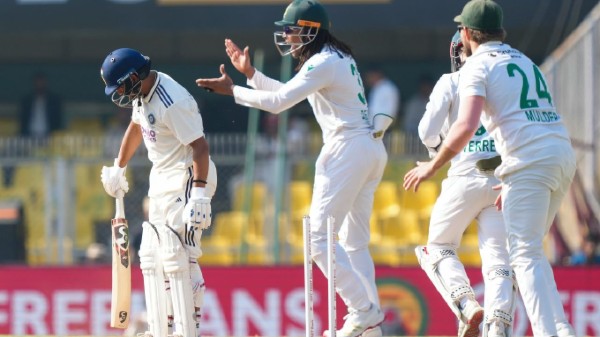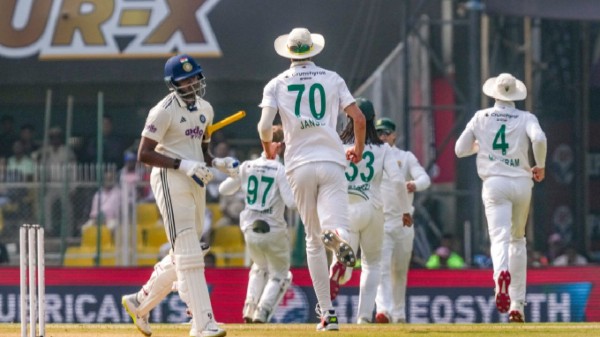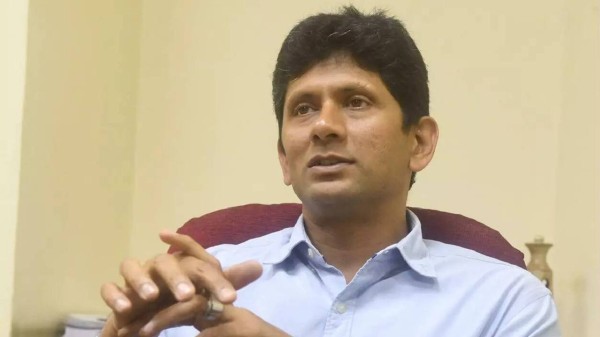

By signing in or creating an account, you agree with Associated Broadcasting Company's Terms & Conditions and Privacy Policy.


By signing in or creating an account, you agree with Associated Broadcasting Company's Terms & Conditions and Privacy Policy.

South Africa were very good but not at their best. They didn't need to be against a clueless Indian side, which seemed lacking in skills, fight and resolve to slump to its biggest defeat in Test cricket. In simpler terms, India were so bad in the two-Test series that the Proteas, without their premier fast bowler Kagiso Rabada in the team and a modest return from their star batter Aiden Markram across four innings, forced the hosts into a meek surrender.
Off-spinner Simon Harmer was the chief destroyer for the Proteas, picking a six-wicket haul in the second innings and finishing with a match haul of nine scalps. The Guwahati humbling marks a dark chapter in India's Test history in the last 12 months. Chasing a 549-run target, Ravindra Jadeja waged a lone battle, scoring an 87-ball 54 as India folded for 140 on the fifth day.
That India suffered a second whitewash at home and lost five Tests against New Zealand and South Africa at home under Gautam Gambhir in a space of mere 12 months is not a coincidence. Several factors have contributed to India's dismal run at home, and one of the biggest is the lack of application by batters and bowlers.
India failed to meet the basic demands of Test cricket. South African players were much superior in technical skill, mental strength, and physical endurance compared to their Indian counterparts, despite not having the home advantage. The dominant performance of the Proteas and the 0-2 scoreline gave the impression that South Africa were the hosts of the series and not the other way around.
The Proteas were able to dominate because they didn't care about conditions. Instead, they focused on the application. The visiting team showed superb application and discipline, something that the Indians lacked. Data shows that the Temba Bavuma-led side were prepared to do the hard yards, especially their batters, who were willing to put their head down and apply themselves on the crease, while Indian batters lacked discipline, application, hunger and mental strength to grind out a gritty performance.
According to ESPN Cricinfo, South African batters spent more time at the crease and faced more deliveries than the Indians across the four innings of the two Tests. While the visitor batted for 1933 balls, Indian batters, in comparison, faced 1470 deliveries - 463 balls or almost 77 overs less than the Temba Bavuma-led side across two Tests.
Number of balls faced in the Kolkata Test
SA 1st innings- 330 balls, IND 1st innings- 374 balls
SA 2nd innings- 324 balls, IND 2nd innings- 210 balls
Number of balls faced in the Guwahati Test
SA 1st innings- 907 balls, IND 1st innings- 503 balls
SA 2nd innings- 471 balls, IND 2nd innings- 383 balls
Overall in the series
SA: 1933, IND: 1470
Stats courtesy: ESPN Cricinfo
The stats paint a clear picture that while South Africa was the visiting team, they adapted to the conditions way better than the Indian batters and accordingly applied themselves. Meanwhile, India, it seems, took the home conditions for granted and expected things to go their way due to the home advantage, and a lot of times went through the motions instead of working hard and smart to make things happen.
It's embarrassing for India that a tail-ender like Kuldeep Yadav managed to face 134 balls in the first innings of the Guwahati Test, making it the highest number of deliveries faced by any Indian batter (later surpassed by Sai Sudharsan's 139-ball knock in 2nd innings) in this series and 38 more in the second innings, and none of the renowned batters could. If Kuldeep was able to demonstrate significant batting resilience, why couldn't the renowned batters do the same?
In bowling, too, South Africans, unlike Indians, were much more disciplined, proactive and smart to take advantage of the conditions and the pitch. Simon Harmer's excellent performance underlined the importance of sticking to the basics. The off-spinner, who was named Player of the Series for picking up a series-high of 17 wickets, doesn't overly rely on variations but focuses on putting the ball in the right areas consistently, almost unapologetically.
Meanwhile, Indian bowlers were unable to hit the right areas long enough to sow seeds of doubt in a batter's mind. That was one of the main reasons that the South African lower middle-order scored heavily and effectively took the match away from India's reach in Assam's capital.
India have soul-searching to do after two home whitewashes in 12 months. With no Test cricket for the next eight months, there is plenty of time to do that for the two-time World Test Championship (WTC) finalists.
That's long enough to find the correct answers and address the issues, but the first step would be to ask the right questions.












